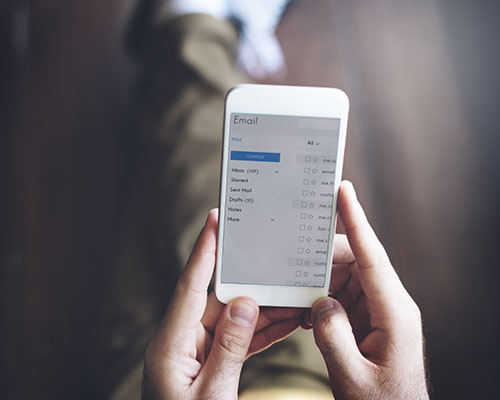- A Reflection of Your Brand
Every email should be an unmistakable extension of your brand. From color schemes to visual cues, consistency reinforces brand identity and fosters familiarity and trust among recipients.
- Stick to Web-Safe Fonts
Fancy typefaces might be fun, but in our diverse digital ecosystem, web-safe fonts are an imperative across all platforms and devices. They are the bedrock of ensuring your message is received as intended.
- Beyond the Visuals
Most financial services firms use Outlook, whose default setting blocks images. So, the essence of your email’s design must lean heavily on HTML text. Since readers typically devote a mere 10 seconds per email, immediate clarity and message delivery are paramount. Visuals can enhance the experience, but don’t rely on them to be the linchpin of the content. When you incorporate images, ensure they’re paired with meaningful ALT text to counteract potential blocking. Of course, you should run tests to evaluate your email’s efficacy sans visuals, keeping in mind that any non-safe font might render differently or be placed in as an image.
- The Video Dilemma
Video can be a potent tool, but their file size renders them a non-starter for emails. Instead, consider using compelling thumbnails or gifs that lead readers to an external link where they can view your content. Again, testing will ensure you’re happy with how a gif displays when it’s static and doesn’t play.

- Underscore Links with Underlining
Links are doorways to deeper engagement. Make them stand out. Underlining, a classic yet potent visual cue, indicates clickable content, ensuring users intuitively understand their next step. This isn’t just aesthetics—it’s a UX best practice borne from years of digital navigation habits. Just keep in mind that your CTAs shouldn’t be all vanilla. Establish a hierarchy: spotlight your email’s primary CTA as a distinct button, while secondary prompts can use subtler buttons or text links. (Newsletters are an exception, as their format must deal with multiple focal points.)
- The Power of Alt Text
Images might fail to load, but your message shouldn’t falter. Utilise alt text effectively to describe images, ensuring that the essence of the visual is conveyed, even when it’s not visible.
- Embracing the 700px Width Limit
In design, every pixel counts. While 700px is the new max width, those extra pixels offer more design freedom. Harness them to provide a richer visual experience without overwhelming your readers.
- The Inverted Triangle Model
Structure is key. Following the inverted triangle model, your design should at first grab your reader’s attention. Lead your reader forward, visually building anticipation, stirring interest and desire. Be sure to conclude by clearly teeing up your compelling call to action.

"In the art of email marketing, design paints the first impression; make sure yours is unforgettable."
- Crafting Scannable Content
An essential tenet of email design is understanding the recipient’s reading journey so you can “guide their gaze”. Initially, users don’t meticulously dissect every word; they skim, gauging whether diving deeper is worth their time. This scanning process dictates the design ethos: content must be organised for quick consumption. Employ bullet points to distill key information, use subheads to signal segment themes, front-load your copy (make the first 2 words impactful) and present information in digestible morsels. A clear pathway—where the most crucial content catches the eye first—can make the difference between a fleeting glance and a click-through.
- Responsive and Accessible for Every Device and Eye
Responsiveness isn’t just an option—it’s a mandate. How will your email render on a compact screen? Will users face the inconvenience of zooming, or will your design intuitively stack for seamless consumption? And responsiveness extends into readability. Optimal body copy sizes hover between 16-18 points, ensuring clarity across devices. As for accessibility, the color contrasts you select should adhere to, at a minimum, AA standards, ensuring that your content is legible and inclusive for all, including those with visual impairments.
In the intricacies of successful email marketing for the financial sector, design and content go hand in hand. By embracing these design best practices, financial marketers can ensure that their emails are not only opened but also read, considered, and acted upon.


